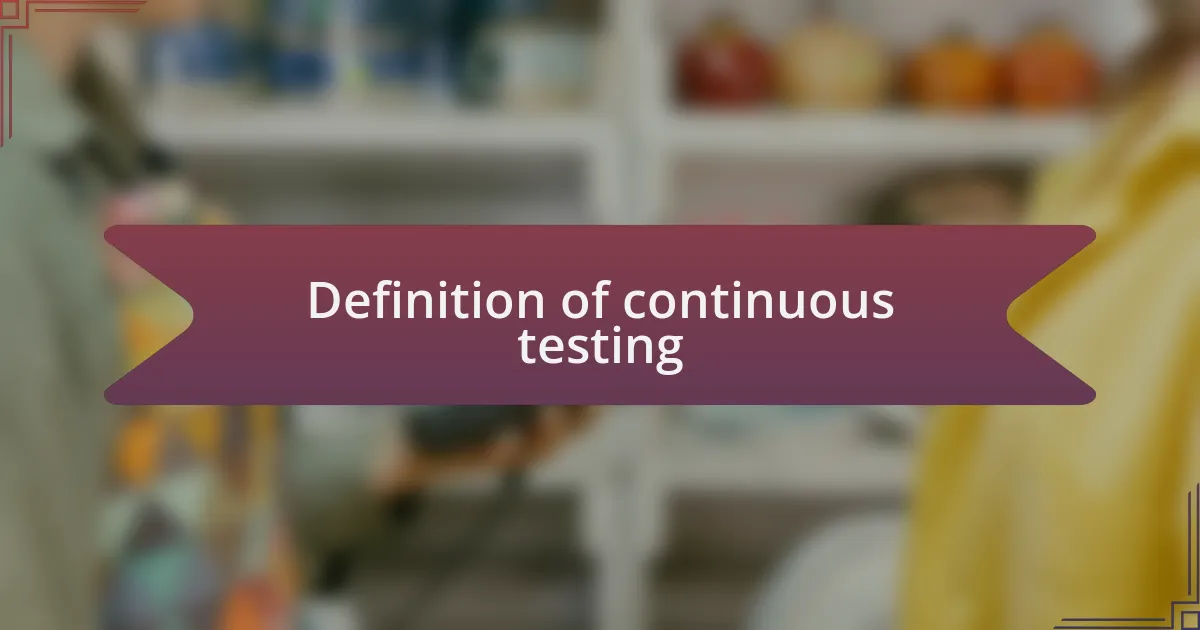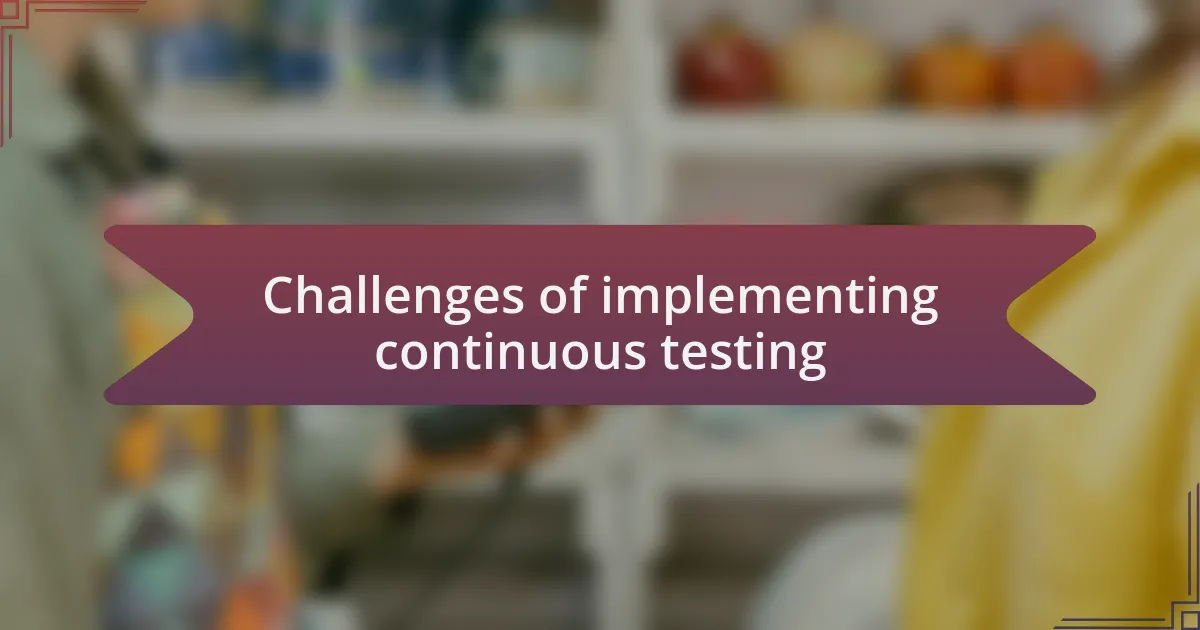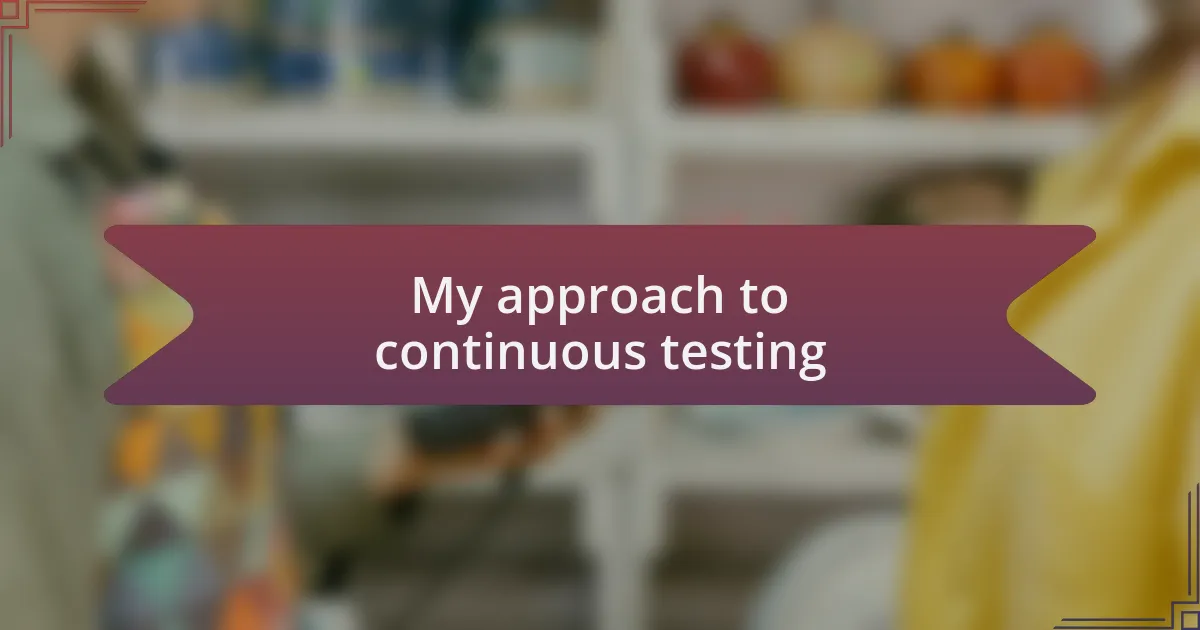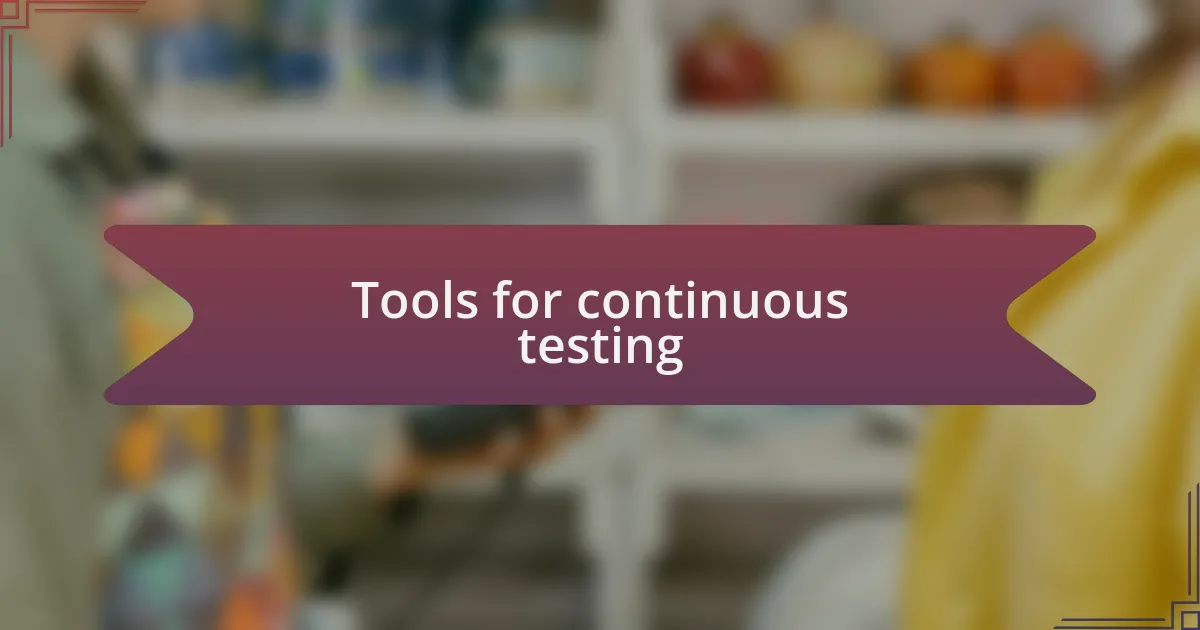Key takeaways:
- Continuous testing enables early defect detection and immediate feedback, enhancing code quality throughout the development lifecycle.
- Collaboration and accountability among team members foster a culture of quality and shared responsibility, leading to smoother releases.
- Automation tools like Selenium and Jenkins streamline testing processes, reducing manual intervention and improving efficiency.
- Documenting testing results provides valuable insights for trend analysis and informed decision-making over time.

Definition of continuous testing
Continuous testing is an integral practice in software development that focuses on evaluating code quality throughout the entire development cycle. It’s not merely about running tests at the end; instead, it involves frequent execution of tests as code changes are made, ensuring that any defects are identified early on. I often recall a time when I overlooked testing until the end of a project, only to face a mountain of bugs that could have been caught earlier – the stress was palpable.
At its core, continuous testing aims to provide immediate feedback on the functionality, reliability, and performance of software. This practice integrates automated tests into a continuous integration/continuous deployment (CI/CD) pipeline, which allows developers to detect issues instantly. Reflecting on my experience, I’ve found that this approach not only boosts productivity but also fosters a culture of quality within teams. Isn’t it reassuring to know that you can detect and fix problems before they escalate into major issues?
The definition of continuous testing also emphasizes its role in enhancing collaboration. By involving testers early in the development process, teams can share insights and make informed decisions based on real-time data. I remember a collaborative project where testers and developers worked hand-in-hand, resulting in a smoother launch and less post-deployment drama. It’s moments like these that highlight the true value of continuous testing—ensuring we deliver high-quality software while minimizing frustration and rework.

Importance of continuous testing
Continuous testing is crucial in today’s fast-paced software development landscape. By consistently evaluating code, teams can catch bugs and vulnerabilities as they arise, rather than waiting for the project’s conclusion. I’ve experienced firsthand how this proactive approach not only saves time but also reduces anxiety associated with looming deadlines and massive bug fixes.
Moreover, the importance of continuous testing extends beyond mere defect detection; it fosters a culture of accountability and collaboration. When everyone on the team—developers, testers, and stakeholders—remains engaged throughout the process, it creates a shared commitment to quality. I recall a project where regular testing sessions became a team ritual, strengthening bonds and enhancing our collective focus on delivering a flawless product. Doesn’t it feel great to know that you’re all in it together, working towards the same goal?
Incorporating continuous testing builds a more stable and reliable software environment. It allows for more frequent releases, which means the end-users receive updates faster and benefit from improvements sooner. I remember a time when a continuous testing approach led to a significant feature rollout much earlier than anticipated, delighting users and giving our team a much-needed morale boost. Isn’t that a win-win for everyone involved?

Benefits of continuous testing
When it comes to continuous testing, one of the most striking benefits I’ve seen is the enhancement of overall product quality. While working on a project where we integrated continuous testing, I observed that our team could identify and address issues early on. This shift not only led to cleaner code but also instilled a stronger sense of pride in our work, as we could genuinely say we produced something reliable and robust. Isn’t it rewarding to know your efforts directly contribute to a better user experience?
Another significant advantage is the accelerated feedback loop that continuous testing provides. I remember a particularly intense sprint where, thanks to our regular testing cadence, we received immediate insights into our changes. This quick iteration cycle allowed us to pivot swiftly based on user feedback. Can you imagine how much time and effort we saved by not waiting for the end of the development process to figure out what worked and what didn’t?
Finally, embracing continuous testing often leads to reduced costs in the long run. From my experience, early detection of defects translates to lower remediation costs. I once saw a project where the initial investment in continuous testing cut down final production expenses dramatically, simply because we addressed issues in real-time rather than incurring hefty late-stage fixes. Isn’t it wise to invest in prevention rather than waiting for problems to snowball?

Challenges of implementing continuous testing
Implementing continuous testing comes with its own unique set of challenges. One notable issue I’ve encountered is the initial resistance from team members who are comfortable with their current processes. I remember a colleague expressing frustration at having to adapt to new testing protocols, which made me realize that fostering a culture of openness and adaptation is crucial. How can we encourage others to embrace change if they don’t see the value in it right away?
Another hurdle is the integration of testing tools with existing development environments. In my past projects, I faced complications when trying to fuse different testing tools, which often resulted in increased setup time and confusion. It’s vital to choose tools that complement your development workflow. Isn’t it frustrating when the tools designed to help us end up becoming more of a headache?
Lastly, keeping test cases updated as code evolves can feel like a never-ending task. I recall a time when a significant update to our application rendered many of our test cases obsolete, demanding hours of rework. This experience pushed me to implement regular reviews of our test cases alongside code changes. How do we ensure that our testing remains relevant in such a dynamic environment? Emphasizing collaboration between developers and testers has been key to overcoming this challenge, allowing us to refine tests in real time.

My approach to continuous testing
My approach to continuous testing hinges on early and frequent feedback. I’ve observed that integrating testing into the development cycle as early as the coding phase reduces the risk of major issues arising later. I remember a project where we implemented automated tests right from the coding stage. This proactive stance not only caught bugs sooner but also fostered a sense of shared responsibility across the team. Isn’t it empowering when everyone feels accountable for quality?
Collaboration stands at the heart of my continuous testing strategy. During one project, I initiated daily stand-up meetings specifically for discussing test outcomes and roadblocks. This practice not only kept everyone aligned but also built trust among team members. I found that when testers and developers engaged together in this way, they became more invested in each other’s work. Have you seen how collaboration can transform the testing landscape?
Finally, I prioritize adapting testing methodologies based on project needs. I recall pivoting from a rigid testing strategy to a more flexible model to accommodate changes in user requirements. This adaptability meant we could quickly redesign our tests to reflect new features. It highlighted that in the fast-paced world of software development, a one-size-fits-all approach simply doesn’t work. Do you agree that being agile in our testing practices can significantly enhance productivity?

Tools for continuous testing
When it comes to tools for continuous testing, I’ve found that leveraging automation is crucial. Tools like Selenium for web applications and JUnit for Java projects have significantly streamlined the testing process in my experience. I still remember a project where implementing Selenium webdriver allowed us to run tests across multiple browsers, catching compatibility issues that would have slipped past us otherwise. Could you imagine the surprises we avoided by identifying these problems early?
Another tool that I’ve become fond of is Jenkins, which helps improve integration and delivery pipelines. Using Jenkins, I was able to automate test execution after each build, effectively minimizing manual intervention. This simple change led to a noticeable decrease in testing time, allowing the team to focus on other critical tasks. It’s incredible how the right tools can create a cascade of positive effects throughout the project, isn’t it?
Lastly, I can’t overlook the importance of integration with issue tracking tools like JIRA or Bugzilla. When my team started linking test results directly with our task management system, we gained better visibility on how identified bugs correlated with development tasks. One specific instance stands out: we noticed a pattern where certain features were failing more frequently than others. This insight allowed us to prioritize our testing efforts effectively. Have you ever experienced that moment of clarity when the right tools paint a clearer picture?

Lessons learned from continuous testing
Continuous testing has taught me the importance of early feedback loops. I recall a project where running smoke tests immediately after each code change revealed issues right away, preventing the chaos of later-stage bug hunting. Have you ever felt the relief when you catch a problem before it spirals out of control? The quicker we adapt, the better our projects thrive.
Another lesson I learned is that collaboration is key. When testers and developers paired up for daily stand-ups, sharing insights became effortless. One time, a developer shared a simple code adjustment that eliminated recurring test failures. I found that fostering open communication led to a smoother workflow and bolstered team morale. Isn’t it fascinating how collaboration can transform challenges into shared victories?
Lastly, I discovered that consistent documentation of testing results is invaluable. Keeping a record of test outcomes helped my team analyze trends over time, identifying persistent issues that needed addressing. It struck me how often we overlook this aspect; having a clear history allows for informed decision-making. Have you ever wished you could go back and see what worked or didn’t? Documentation gives us that powerful ability, making our testing processes more effective in the long run.